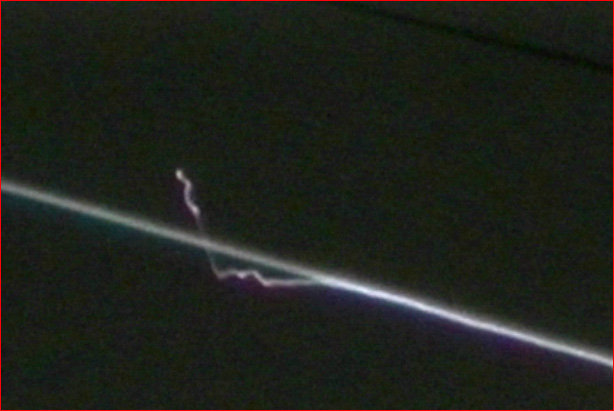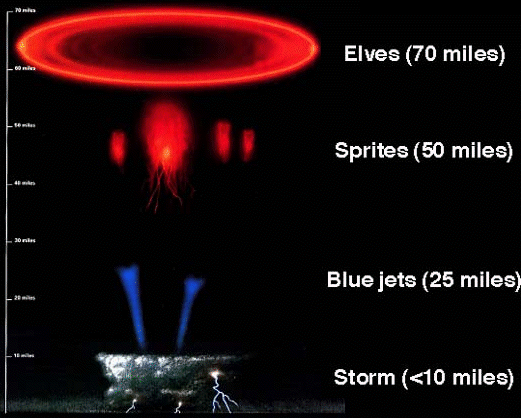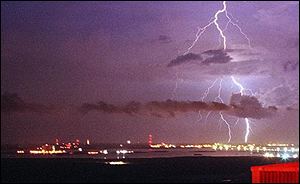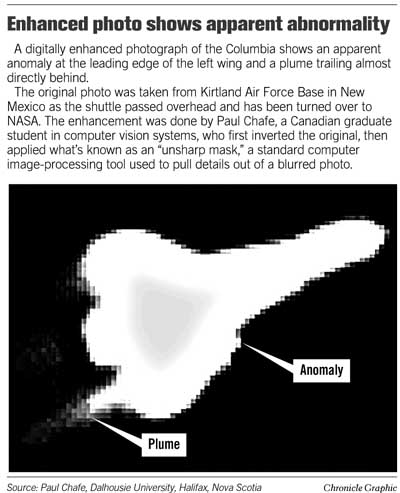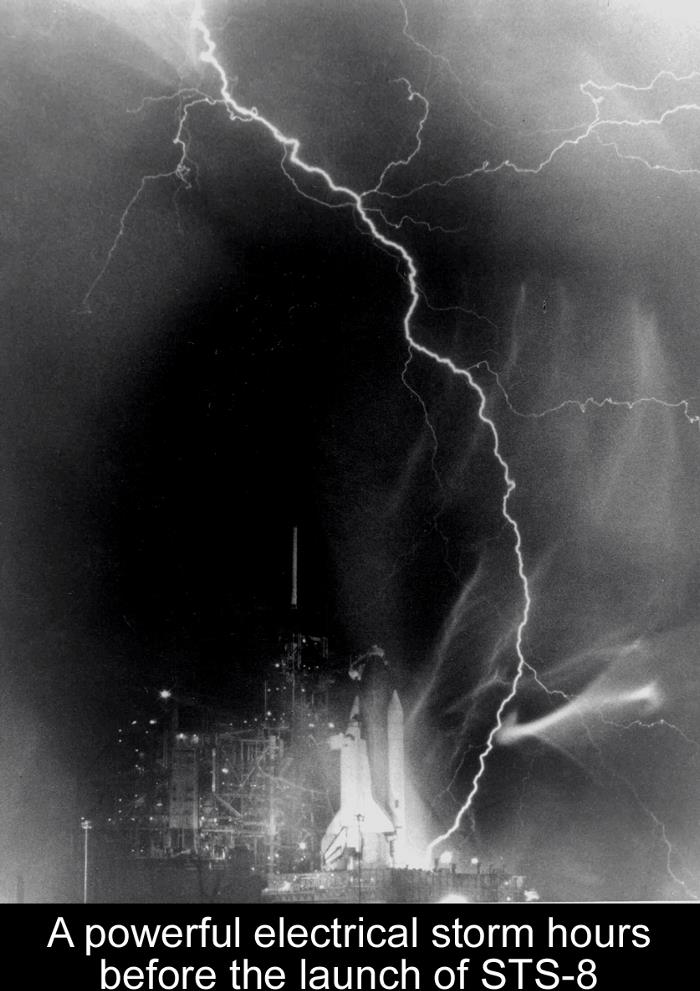|
Columbia Taken Out by Lightning? |
||
This photo was taken by an amateur astronomer from the San Francisco area. In the photograph a purplish corkscrew streamer merges with the plasma trail of the shuttle, which then brightens significantly. NASA scientists looked at the photograph and dismissed the corkscrew streamer as an artifact created by jiggling of the camera. The NASA 'explanation' was not accompanied by any published analysis, only a statement that there was no thunderstorm activity below Columbia when the photograph was taken. The reference to an "absence of regional storm activity" implies that scientists know what causes lightning. On the contrary, a world authority on the subject, Dr. Martin Uman, admits that the cause of the charge separation that results in lightning in a thunderstorm is not understood. It is simply a belief that thunderstorms somehow generate lightning. Additional Details
Electric charge has recently been found to sit high above thunderstorms, in the lower ionosphere. Contrary to popular belief, it is electric charge from space that lights up the stratosphere with weird phenomena called 'sprites' and 'elves' and drives violent thunderstorms below. However, it doesn't always require a thunderstorm below to trigger a discharge from the ionosphere. Large meteors sometimes act as a trigger. Uman cites many reports of lightning occurring from a clear blue sky. And the plasma trail of a re-entering shuttle would do nicely as an ionospheric 'lightning rod'. Dr. Alfred Beddard of the National Oceanics and Atmospherics Administration, who was the first to record powerful infrasound from high-altitude sprites, had his array of detectors trained on the shuttle re-entry path. He had recorded the sounds of shuttle re-entries before. This time he detected an unusual "geophysical event, as powerful as an earthquake" close to the shuttle's path, moments before Columbia's breakup. Why hasn't it happened yet? Well gee, the Sun does
seem a lot hotter these days and the weather is getting worse and if the
charge separation that creates lightning is also driving our weather then
there you go. They were racing against the clock to get back, but didn't
make it in time.
SOURCE: Yahoo Answers |
||
Related Links:
|
||
|
.
This amazing picture shows powerful discharges on three levels. the smaller bolts arcing from cloud to cloud. This storm caused the Shuttle launch to be delayed... Excerpt The space shuttle Columbia is being prepared at the Kennedy Space Center in Florida for an historic mission that has already suffered two last-minute postponements. And the pressure is on for today's launch, scheduled for 0031 EST (0431 GMT). Thunderstorms near the launch site prompted Nasa officials to cancel Wednesday's scheduled launch. 'Flight no-go' Mission Control explained to the crew that lightning strikes were reported within 10 miles of the launch site. A 20-mile clearance is required for a safe launch, as a lightning strike could in theory ignite the hydrogen fuel in the shuttle's main tank. "It's a flight no-go," the launch controller, Ralph Roe, told Commander Eileen Collins. "We'll give it another try on another day." The countdown was stopped five minutes from ignition as controllers waited for the storm to abate - and the launch "window" was extended by 10 minutes - but to no avail. SOURCE: BBC News |
||
|
.
S.F. astronomer's is among those
looked at by newly created panels
Enhanced Photo Shows Apparent Abnormality. Chronicle Graphic NASA investigators of the Columbia space shuttle disaster have set up a study group to analyze a photograph, taken by an amateur astronomer from a San Francisco hillside, that appears to show a bolt of electricity striking the doomed orbiter as it streaked across Northern California. General Michael Kostelnik, deputy associate administrator for the shuttle program, told reporters in Washington, D.C., Monday that "the lightning-strike photo . . . is being studied carefully to see what it means." Separate study groups, consisting of both government and private experts, have been convened to analyze the San Francisco photograph and an image taken by a sophisticated tracking camera at Kirtland Air Force Base that was following the shuttle as it passed over New Mexico. The Air Force shot shows a silhouette of Columbia with apparent damage to its left wing. Kostelnik confirmed Monday that a piece of the shuttle's left wing was found on the ground near Lufkin, Texas. NASA is pooling the images from amateur videotapes, amateur photos and data from secret government cameras, and attempting to correlate them with data transmitted from the stricken craft to piece together the sequence of events that led to Columbia's breakup over Texas on February 1. "We're looking at all the events during that time period," Kostelnik said. In addition to visual images, investigators are poring over radar data and tapes from a bank of exotic "infrasonic" sensors that can actually pick up the noise of the space shuttle's re-entry over California. If the San Francisco photograph does indeed depict a bolt of electricity in the ionosphere, the "infrasonic" sensors in Colorado might be able to detect the faint thunderclap that accompanied it. The San Francisco photograph, which has not been released publicly by the astronomer, was transmitted directly to the shuttle's chief engineer Ralph Roe Jr. on February 4, and a copy of the image, as well as the camera that took it, were flown to Houston the next morning. At previous press conferences, NASA officials have said they were trying to assess the "validity" of the image, which was taken during the time when sensors on the shuttle's left wing first showed indications of a problem. On Thursday, shuttle program manager Ron Dittemore said there were no indications, based on flight data transmitted from Columbia at the time the photo was snapped, that the orbiter had experienced any unusual electrical event. "There is nothing in the data stream . . . that would cause any concern on our part," he said. The digital photograph, the third in a series of five taken by the San Francisco astronomer as he faced the northern sky, contains many visual cues -- such as a star field -- that should allow NASA scientists to pinpoint the moment the unusual image appeared, and compare it with signals transmitted from Columbia. An analysis presumably could also quickly determine whether the image could have been caused by a jiggling of the camera during the time lapse photograph. It was taken using a Nikon M-880 camera, using an automatic exposure, triggered by finger. Although the astronomer refuses to release the picture, he permitted two Chronicle reporters to view it last week. In the critical shot, a glowing purple rope of light corkscrews down toward the plasma trail created by the shuttle, appears to pass behind it, then cuts sharply toward it from below. As it merges with the plasma trail, the streak itself brightens for a distance, then fades. There were no unusual images visible in the other four pictures. NASA administrator Sean O'Keefe told reporters that the agency has quickly established a system to collect photographic information from private citizens while protecting "their proprietary rights" to the images. "We've even figured out how to move lawyers expeditiously," he said. E-mail Sabin Russell at srussell@sfchronicle.com SOURCE: San Francisco Chronicle |
||
| No sign nature downed Columbia
Analysis of sounds kills theory that lightning hit space shuttle Sabin Russell, Chronicle Staff Writer Thursday, June 5, 2003 SOURCE: San Francisco Chronicle Henry Bass led a team of experts in the science of low-fr... There were no lightning strikes and no meteorite hits as the space shuttle Columbia made its doomed re-entry over the western United States, according to an analysis of sounds of the shuttle's fiery return, caught by a network of extraordinary electronic ears. A team of experts in the science of low-frequency sound wave detection completed their analysis for the Defense Department two months ago and made the study public Wednesday. Inside NASA, their report helped put to rest theories that an electrical discharge or a collision with a meteorite might have played a role in the tragedy. "There had been a suggestion of a high-altitude lightning strike," said study leader Henry Bass, director of the National Center for Physical Acoustics at the University of Mississippi. "But had that been the case, we would have seen other data. There were no such data." Fueling speculation that some sort of electrical strike might have damaged Columbia was a photograph taken by an amateur astronomer in San Francisco. It appeared to show a bolt of electricity corkscrewing toward Columbia. The image was taken when the shuttle was above Northern California. Although NASA has declined requests for a copy of its analysis of the image, spokeswoman Patricia Brach has told The Chronicle that investigators concluded that it was probably created by accidental camera movement. "At this time, it appears to be camera jiggle," she said. Neither NASA nor the San Francisco photographer has released the photograph, which was described in February by Chronicle reporters who were shown it before it was shipped to Houston for analysis. NASA officials took the photograph seriously enough that they enlisted experts in low-frequency sound waves, or "infrasound," to look for evidence of a faint thunderclap at the time the photograph was taken. The unique quality of infrasound is that it carries for thousands of miles. Infrasonic arrays can detect volcanoes erupting, the hiss of meteors, lightning strikes and the sound of space shuttles returning home. Although the scientists did not find evidence of a celestial thunderclap in the recording of Columbia's descent, there were some curious findings. The network of 10 infrasonic stations -- spread from Hawaii to Texas -- picked up an unusual burst of sound as the shuttle passed over the California-Nevada border. The sound occurred at the same moment that a photographer near Reno snapped pictures showing a brightening of the shuttle's plasma trail. Too little is known about the soundtracks of shuttle re-entries to make much of the spike in the sound signal, but Bass said it was most likely caused when Columbia fired its rockets to change its angle of attack, perhaps in a computer-guided attempt to compensate for the increasing drag on its damaged left wing. "When you turn a little, you can get a much-enhanced shock wave," Bass explained, during a telephone press conference. A variety of S-shaped turns are executed during a shuttle re-entry to reduce speed, but no other maneuvers of this sort triggered a spike of low-frequency sound. Columbia's final pass over the Pacific and the western United States ended in a shower of debris over thousands of square miles of Texas and Louisiana. Investigators believe a piece of foam insulation from a fuel tank knocked a hole in the leading edge of Columbia's left wing during launch that, two weeks later, caused the doomed spaceship to disintegrate during re-entry. Although the destruction of Columbia occurred in a matter of minutes, the infrasound detectors picked up signals for nearly an hour, as distant sounds traveling hundreds of miles -- and blown about by winds -- finally reached the detectors. As the shuttle came apart over Texas, the single wave of sound broke into hundreds of smaller signals as each piece of debris created its own supersonic wake. Although the thrust of the infrasound report is that nothing unexpected was revealed by infrasound signals, other scientists are not so certain. In a separate report, NASA physicist Alfred Bedard, of the NOAA Environmental Technology Laboratory in Boulder, Colo., said Columbia's infrasound signature did show subtle differences from those of other shuttles re-entries he had tracked. Bedard, an expert in detecting the infrasound signatures produced by high atmospheric lightning known as sprites, agreed that there were no sounds of sprites on the tapes. However, he said that Columbia's trailing wake contained infrasonic "impulses" he'd not detected before. "These surges, to me, were unusual," Bedard said. He said they could have been caused by the shedding of debris, or by the rapid firing of thruster rockets as Columbia's computers sought to keep the orbiter stable. His report recommends further study, to compare those signals more precisely to events tracked in the shuttle's flight data recorder. E-mail Sabin Russell at srussell@sfchronicle.com SOURCE: San
Francisco Chronicle
|
||
| Wild Blue Yonder: San Francisco
Photos indicate Shuttle Columbia was struck by Hyper-Lightning on Reentry
by Guy Cramer Excerpt The Photos NASA won't yet release to the public concerning lightning apparently striking the Shuttle Columbia on reentry over San Francisco minutes before the breakup have been released in the United Kingdom on a TV documentary called Megalightning. The Columbia Accident Investigation Board reviewed the photos but claimed that the anomaly must be due to camera shake and not an actual lighting strike as no thunder storm was in the local area as had been seen in previous research on high altitude lightning. I have posted these photos from the TV show below. Since receiving these photos in January 2005 provided from Andy Robins (used from the documentary), I have requested the actual photos directly from NASA Administration through the Freedom of Information Act but have not received anything in six months. The evidence within the photos is contrary to the CAIB expert evaluation which may be why the photos have been kept out of public scrutiny. I corresponded with NASA JPL about three years ago on a research program, they required an expert in Air Ions and had been told I was the expert. They said at the end of the research that I had saved them 10-15 years of time with the material I provided them. Understandably when the Columbia accident occurred, due to the region of the atmosphere where the initial problems occurred (ionosphere) I began to conduct my own research which was later reviewed by the CAIB. |
||
|
.
|
||
| See Also our pages on "The Electric Universe" | ||
| FAIR USE NOTICE: This page contains copyrighted material the use of which has not been specifically authorized by the copyright owner. Pegasus Research Consortium distributes this material without profit to those who have expressed a prior interest in receiving the included information for research and educational purposes. We believe this constitutes a fair use of any such copyrighted material as provided for in 17 U.S.C § 107. If you wish to use copyrighted material from this site for purposes of your own that go beyond fair use, you must obtain permission from the copyright owner. | ||
|
|
